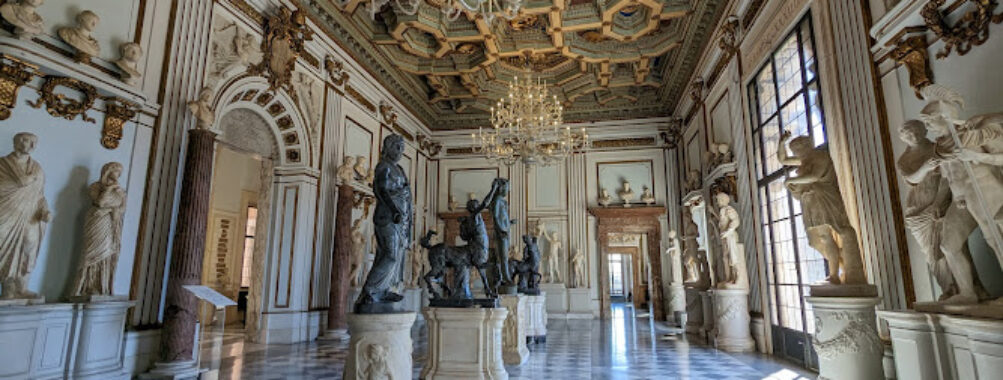
Capitoline Museums
“`html
Table of Contents
Description
The Capitoline Museums are not just another stop on a sightseeing checklist; they’re a deep dive into the very heart of Rome’s identity. Perched on Capitoline Hill, the museums are spread across two palaces designed by none other than Michelangelo himself. Inside, you’ll find classical Roman, Greek, and even Egyptian sculptures alongside Renaissance masterpieces. It’s the kind of place where you can stand face to face with the legendary Capitoline She-Wolf, gaze at the dignified equestrian statue of Marcus Aurelius, or lose yourself in the haunting beauty of the Dying Gaul.
What makes the experience even more fascinating is the way the collections are displayed. You don’t just walk past art on sterile white walls; instead, the works are framed by centuries-old architecture. The setting itself feels like part of the exhibit. And while most travelers rave about the grandeur, some do find the layout a bit confusing or overwhelming. That’s fair—these museums are vast, and it’s easy to feel like you’ve stepped into a labyrinth of history. But honestly, isn’t that part of the charm? Wandering through corridors where emperors once walked, stumbling upon sculptures that have survived millennia—it’s hard not to be awestruck.
The museums also manage to be surprisingly approachable. Families with kids often enjoy the mythology behind the wolf and twins, while art lovers can spend hours with the Renaissance paintings. Accessibility is thoughtfully considered as well, with wheelchair-friendly entrances and restrooms. The only thing you won’t find here is a restaurant, so it’s wise to grab a bite before or after your visit.
Key Features
- Michelangelo-designed palaces housing the collections
- Iconic sculptures such as the Capitoline She-Wolf and the Dying Gaul
- Equestrian statue of Marcus Aurelius, one of Rome’s most famous symbols
- Blend of Roman, Greek, Egyptian, and Renaissance art
- Expansive halls filled with ancient inscriptions and architectural fragments
- Panoramic views of the Roman Forum from the museum terraces
- Wheelchair accessible entrances and restrooms
- Ideal for families, with exhibits that spark curiosity in kids
Best Time to Visit
If you’re like me and prefer a quieter museum experience, mornings right after opening are golden. The crowds haven’t yet flooded in, and you can take your time soaking in the details without feeling rushed. Weekdays tend to be calmer than weekends, especially outside of the peak summer tourist season. Spring and autumn are particularly lovely because the weather is comfortable enough for the walk up Capitoline Hill, and the light filtering through the windows gives the statues this almost ethereal glow.
Summer is, of course, the busiest. If that’s when you’re traveling, don’t worry—you can still enjoy it. Just book your tickets in advance and aim for late afternoon when the tour groups have thinned out. Personally, I think winter visits are underrated. Yes, the days are shorter, but the atmosphere is quieter, and you really get the sense of having the galleries all to yourself.
How to Get There
Reaching the Capitoline Museums is straightforward since they’re right in the historic center of Rome. If you’re staying nearby, walking is the most rewarding option. You’ll pass through some of the city’s most famous piazzas and streets, and the approach to the Capitoline Hill itself is unforgettable. For those relying on public transport, buses stop close by, and the Colosseo metro station is within walking distance. Taxis and rideshares can drop you off nearby, though they can’t always get you right to the top of the square, so expect a short walk.
I once made the mistake of driving in central Rome—never again. Between the traffic, the ZTL restricted zones, and the lack of parking, it’s just not worth the headache. Save yourself the stress and stick to walking or public transport.
Tips for Visiting
First and foremost, buy your tickets in advance. The museums are popular, and waiting in long lines under the Roman sun is nobody’s idea of fun. Once inside, don’t rush. The collections are massive, and trying to see everything in one go is exhausting. Instead, pick a few highlights you absolutely want to see, then allow yourself to wander for the rest.
Wear comfortable shoes—those marble floors are beautiful but unforgiving after a couple of hours. Bring a bottle of water too, especially in summer. And since there isn’t a restaurant inside, plan your meal around your visit. There are plenty of trattorias and cafés nearby where you can refuel with pasta or a quick espresso.
Photography is allowed in most areas, so bring your camera, but remember to put it down now and then. Standing in front of a statue that’s survived two thousand years is a moment worth experiencing with your own eyes. Families with kids should take advantage of the storytelling potential—my niece still talks about the wolf and twins years after her visit.
Lastly, give yourself time to step out onto the terraces. The views over the Roman Forum are breathtaking, and it’s one of those spots where you really feel connected to the layers of history beneath your feet. For me, that’s always the moment when the chaos of Rome falls away, and you’re left standing in quiet awe of the city’s past.
“`
Location
Places to Stay Near Capitoline Museums
Find and Book a Tour
Explore More Travel Guides
No reviews found! Be the first to review!